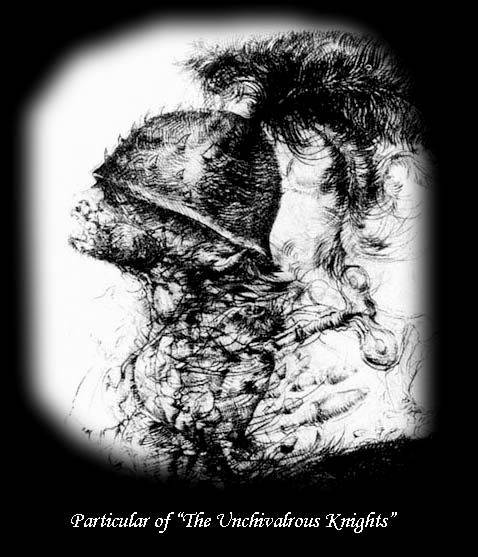SIGNS OF THE FANTASTIC
The life and works of Mario Scarpati are connected to the fantastic like a leitmotif. His imagination seems to know no bounds. He claims to have died on 23rd January, 1939 and to have been born in the seventeenth century, the age of baroque, with its spectacular and highly intense, realistic and sensorial scenic effects. The Neapolitan artist’s early memories are of the ‘liberating’ planes bombing his city during the second world war, and the rain of ash from the last eruption of Vesuvius. Ha has always loved solitude, darkness and silence, so as to absorb himself in the primitive and to capture its symbols. His teachers are the masters of the past: his sign is a revival of the great tradition, evident from his early seascapes, etched in 1958.
With brutal realism and fantastic Breughelian expression he portrays the underprivileged of his neighbourhood.
Considered among
the finest and most interesting contemporary Italian engravers (Antonio del
Guercio), already in 1972 he won the gold medal at the III Biennale
Internazionale della Grafica in Florence with a METAMORPHOSIS as, like Kafka,
he considers some men to be insects.
“His generous and deeply-felt interest in the destiny of others is extraordinary” (Giorgio Trentin, 1976). His anatomical drawings and his embryonic studies with their Leonardesque dynamism in the complex geometrical structures of the EROTIC POMPEI MURALS are fantastic.
Sergio Miniussi in 1980 had understood “Visions and dreams and waking nightmares are recounted like a judicial report. Contempt, irony, a destructive and surreal force are well to the forefront, leaning towards the blood-related Goya and Grosz.
The UNCHIVALROUS KNIGHTS, triumphant ninnies over a ruined universe are a body blow to those who want flowers and seascapes. When the Fine Arts Academy in Leipzig invited him for an exhibition in 1982 -1983 he presented forty-five dry points, defined as extremely coherent by Grigore Arbore on the occasion of the personal exhibition at the Italian Cultural Institute in Bucharest in 1983. In 1998 he donated them to the national print museum in Mexico City.
Far from majority tastes, he involves those who can hear the cries and the confusion caused by the tragic puppets in power.
“Through phantasmogorical chiaroscuri and ‘alienating’ figures, the Neapolitan artist seems to accept the Platonic equation of graphic sign and death”.
“He adopts the high ethical value of denunciation, as a stimulus to a way of thinking and to a way of achieving a clear conscience on things and, in the mixing of images he is able, perhaps better than any page of literature, to show us the abysses around us, and he invites us to meditate on our own destiny.” (Alfonso Maria di Nola)
In 1987 the Norwegian Nobel Peace Prize Committee, on the occasion of his exhibition at the Italian Cultural Institute in Oslo, expressed their “gratitude for the way in which he uses his enormous artistic powers for this important cause.”
This has also been his message to the pupils of the Art School for the last thirty years.
In 1994 he moved with his wife to Trieste, the windy city. He has transcribed the difficulty of life in the world with hundreds of drawings. He brings together the little monsters of Bosch, the skeletons and devils of Durer, the pustular Christs of Grunewald, the bourgeois disgraces of Grosz and even Picasso’s Minotaur. THE END OF THE MILLENIUM BESTIARY is a vortex of metal helmets, bullets, phalluses, claws, bones and skulls. “His repertoire, similar to a left luggage deposit, enables him to stage his stories, and allows him to turn tragedy into the grotesque, the scornful denunciation. Having set up his theatre of violence and horror with the ease of the great virtuoso, he exhibits on the cusp of the incredible. Nevertheless, these are not lies. He shows us more about the world than the sullen guardians of the truth (Vitaliano Corbi).
THE CONSUMER BEAST has extraordinary power.
Mechanical puppets hover around the vice of ITALIAN RITUAL. In the bodies, in the chaotic shattering of form, the fantastic sign becomes one of shock, a deadly shudder.
“The images, similar to the ancient Judaeo-Christian and medieval apocalypses, leading us to myth and to dreams, create the catharsis of the deliverance from evil. Scarpati sees himself as the avenging angel. He cries to the world, in a rush of civil religion, that the seduction of Satan is not over” (Vittorio Laternari, anthropologist, 1997).
The profane nihilism and the weakness of Christians are threatening. Italy, a bit provincial and a bit American colony, is destined to collapse. Hope lies in biting satire.
An intense and visionary realist, troubled and tormented, he is looking for a new humanism, and he imposes it with extravagant colours and shortened images.
He has ensured identity and integrity in his work. The bimillenary civilization is falling apart. What is revealed as essential is the body, subject to the follies of history. The artist warns that the lamb will be devoured. The dream of reason creates monsters: terrible wild beasts, chimeras, seductive sirens, evil harpies, and film goddesses. Lascivious nudes explode in a grandiose beauty, carnally domineering.
He can give the
impression of a morbose, obscure, obsessed artist; on the contrary he loves
life. He screams his great indignation towards widespread wrongdoing with
sneering masks in grotesque scenes. The merchants of the future will be arms
traffikers and drug dealers. But the artist is always on the lookout for a
better world.
Elsa Fonda
traduzione di Chris Taylor